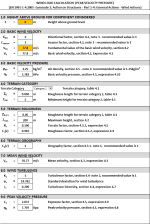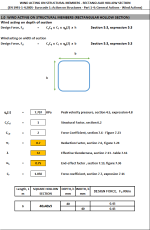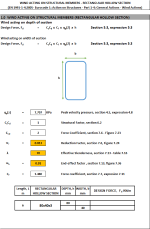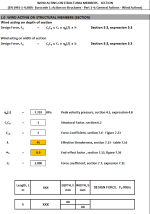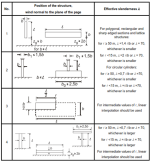WIND LOAD on structural steel Eurocode 1
Description
Calculation Reference
Structural Steel
Wind Loads
Eurocode 1
Wind loads are a crucial part of the structural analysis and design process. They're calculated according to the Eurocode 1: Action on Structures - Part 1-4: General Actions - Wind Actions (EN 1991-1-4:2005). The procedure generally involves the determination of wind velocity, wind direction, and structural form. The Eurocode includes different methods for calculating wind loads, but the standard method is to determine the peak velocity pressure.
Here is a general outline of how to calculate wind loads acting on structural members, with a focus on square hollow sections, rectangular hollow sections, and regular sections:
-
Basic wind speed (v_b): This is determined from the Eurocode 1 wind map, taking into account the location of the site.
-
Calculate the mean wind velocity (v_m): Adjust the basic wind speed for the altitude of the site, the type of terrain, and the height above ground level.
-
Determine the peak velocity pressure (q_p): This is calculated from the mean wind velocity, and it represents the pressure exerted by the wind on the structure. The formula used is q_p = 0.5 * ρ * v_m^2, where ρ is the air density (approximately 1.25 kg/m³).
-
Wind actions on individual structural members:
- Square and Rectangular Hollow Sections: The wind force acting on these members is calculated by multiplying the peak velocity pressure by the area of the member exposed to the wind. If the member is oriented such that one of its flat sides is facing the wind, then the full area of that side is used. If it is oriented such that an edge is facing the wind, then the effective area is smaller and must be calculated based on the angle of the wind.
- Regular Sections: The wind force is calculated in the same way, by multiplying the peak velocity pressure by the effective area exposed to the wind. The effective area depends on the shape of the section and the angle of the wind.
-
Calculate the wind loads: These are calculated by multiplying the wind force by a shape factor (C_f), which takes into account the shape of the structure and the direction of the wind. The Eurocode provides tables for determining this factor based on the shape of the section and the angle of the wind.
-
Combine the wind loads with other loads: Finally, the calculated wind loads are combined with other loads (such as dead loads and imposed loads) in a load combination to check the structure for safety and serviceability.
Remember, when calculating wind loads, it is necessary to consider the dynamic and temporal effects of wind. In certain cases, more complex analyses may be required to accurately predict wind-induced responses.
Calculation Preview
Full download access to any calculation is available to users with a paid or awarded subscription (XLC Pro).
Subscriptions are free to contributors to the site, alternatively they can be purchased.
Click here for information on subscriptions.


